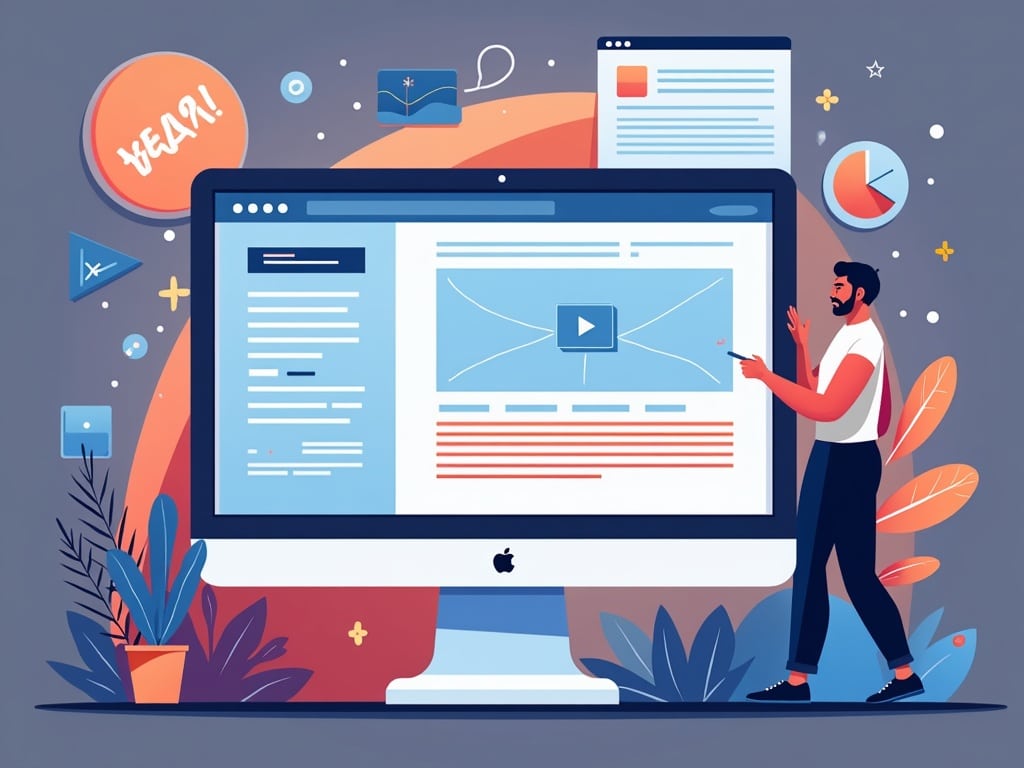Webinar Landing Page Best Practices: Convert Visitors into Attendees
Imagine you've poured your heart and soul into creating a webinar packed with valuable insights. You've lined up compelling speakers, crafted a killer presentation, and are ready to share your expertise with the world. But there's a catch: if your landing page doesn't grab attention and convert visitors into attendees, all that effort will be for naught. In the fast-paced digital landscape, a well-optimized webinar landing page is your virtual gatekeeper, determining whether potential attendees click register or simply scroll on by. This guide delves into the essential webinar landing page best practices to help you maximize sign-ups and ensure a successful event.
Understanding the Anatomy of a High-Converting Webinar Landing Page
Before diving into specific tactics, let's break down the key elements that make up a high-converting webinar landing page:
- Headline: Your headline is the first (and often only) impression you make. It should be concise, compelling, and clearly communicate the webinar's value proposition.
- Subheadline: Expand on your headline, providing further context and addressing the audience's pain points.
- Visuals: High-quality images or videos can dramatically increase engagement and convey information quickly.
- Webinar Description: Clearly outline the topics covered, the benefits of attending, and the key takeaways for attendees.
- Speaker Information: Showcase the expertise and credibility of your speakers with headshots and brief bios.
- Registration Form: Keep the form short and sweet, asking only for the essential information needed for registration.
- Call to Action (CTA): Use clear and compelling CTAs that encourage visitors to register, such as Register Now, Save Your Spot, or Join Us Live.
- Social Proof: Include testimonials, social media mentions, or attendee counts to build trust and credibility.
Crafting a Killer Headline and Subheadline
Your headline is arguably the most crucial element of your landing page. It's the first thing visitors see, and it determines whether they stick around to learn more. Here are some tips for crafting a killer headline:
Focus on the Value Proposition: What will attendees gain by attending your webinar? Highlight the key benefits in your headline. For example, instead of Webinar on Content Marketing, try Learn How to Double Your Website Traffic with Content Marketing.
Use Strong Action Verbs: Start your headline with a verb that compels action, such as Discover, Learn, Unlock, or Master.
Create a Sense of Urgency: Use time-sensitive language to encourage immediate registration. For example, Limited Spots Available or Register Now to Save Your Spot.
Keep it Concise: Aim for a headline that's easy to read and understand at a glance.
Your subheadline should expand on your headline, providing further context and addressing the audience's pain points. Use it to elaborate on the benefits of attending and highlight the specific problems the webinar will solve.
Leveraging Visuals to Boost Engagement
Humans are visual creatures. High-quality images and videos can significantly enhance engagement and make your landing page more appealing.
Use Professional-Quality Images: Avoid using stock photos that look generic or staged. Opt for high-resolution images that are relevant to your webinar topic and target audience.
Incorporate Video: A short promotional video can be a powerful way to showcase the value of your webinar and introduce your speakers. Consider including clips from past webinars or testimonials from satisfied attendees.
Optimize Images for Speed: Large image files can slow down your landing page, hurting your conversion rates. Compress your images to reduce file size without sacrificing quality.

Writing a Compelling Webinar Description
Your webinar description should provide a clear and concise overview of what attendees can expect to learn. Here are some tips for writing a compelling description:
Focus on the Benefits: Emphasize the key takeaways and how attendees will benefit from attending. Use bullet points to make the information easy to scan.
Address Audience Pain Points: Identify the problems your target audience is facing and explain how your webinar will help them solve those problems.
Highlight the Expertise of Your Speakers: Showcase the credentials and experience of your speakers to build credibility and trust.
Use Clear and Concise Language: Avoid jargon and technical terms that may confuse or alienate your audience.
Optimizing Your Registration Form
Your registration form is a critical point of conversion. A complicated or lengthy form can deter potential attendees. Keep it simple and ask only for the essential information you need.
Minimize the Number of Fields: Only ask for the information you absolutely need, such as name, email address, and maybe company name or job title.
Use Clear and Concise Labels: Make sure the labels for each field are clear and easy to understand.
Consider Using Smart Fields: Smart fields can automatically populate information based on previous interactions or data, making the registration process even faster and easier.
Ensure Mobile-Friendliness: Make sure your registration form is optimized for mobile devices, as a significant portion of your audience will likely be accessing it on their smartphones or tablets.
Crafting a Powerful Call to Action (CTA)
Your call to action (CTA) is the final nudge that encourages visitors to register. It should be prominent, visually appealing, and clearly communicate the desired action.
Use Action-Oriented Language: Use strong verbs that encourage immediate action, such as Register Now, Save Your Spot, Join Us Live, or Sign Up Today.
Make it Visually Appealing: Use a button with a contrasting color that stands out from the rest of the page.
Create a Sense of Urgency: Add a sense of urgency to your CTA by highlighting limited availability or a registration deadline.
A/B Test Your CTAs: Experiment with different wording, colors, and placements to see which CTAs perform best.
Leveraging Social Proof to Build Trust
Social proof is a powerful psychological phenomenon that influences our decisions based on the actions of others. Incorporating social proof on your landing page can significantly increase registration rates.
Testimonials: Include testimonials from past attendees who have benefited from your webinars.
Social Media Mentions: Display positive social media mentions or tweets about your webinars.
Attendee Count: Show the number of people who have already registered to create a sense of social validation.
Logos of Prominent Attendees/Companies: If you've had attendees from recognizable companies, display their logos to build credibility.
Mobile Optimization: Reaching Attendees on the Go
In today's mobile-first world, it's crucial to ensure your webinar landing page is fully optimized for mobile devices. A responsive design that adapts to different screen sizes will provide a seamless user experience for visitors on smartphones and tablets.
Use a Mobile-Friendly Template: Choose a landing page template that is specifically designed for mobile devices.
Optimize Images for Mobile: Compress images to reduce file size and improve loading speed on mobile devices.
Ensure Easy Navigation: Make sure the navigation is simple and intuitive on mobile devices.
Test on Different Devices: Test your landing page on a variety of mobile devices to ensure it looks and functions correctly.
A/B Testing: Continuously Improving Your Landing Page
A/B testing is the process of comparing two versions of a landing page to see which one performs better. By continuously testing different elements of your landing page, you can identify what works best for your audience and optimize your conversion rates.
Test One Element at a Time: To get accurate results, test one element at a time, such as the headline, CTA, or image.
Use a Reliable A/B Testing Tool: Use a reliable A/B testing tool to track your results and identify statistically significant differences between the two versions.
Track Your Results: Carefully track your results and use the data to inform your future landing page optimizations.
Don't Be Afraid to Experiment: Be willing to experiment with different ideas and approaches to see what resonates with your audience.
Promoting Your Webinar Landing Page
Creating a stunning webinar landing page is only half the battle. You also need to promote it effectively to drive traffic and generate registrations.
Email Marketing: Send targeted email campaigns to your subscriber list.
Social Media: Promote your webinar on social media platforms.
Paid Advertising: Consider using paid advertising platforms like Google Ads or social media ads to reach a wider audience.
Content Marketing: Create blog posts, articles, and other content that promote your webinar and drive traffic to your landing page.
Partner with Influencers: Collaborate with influencers in your industry to promote your webinar to their followers.
Conclusion: Your Gateway to Webinar Success
In the competitive world of online events, a well-crafted webinar landing page is the key to unlocking a flood of engaged attendees. By implementing these webinar landing page best practices, focusing on a clear value proposition, and continuously optimizing your page with A/B testing, you'll transform casual visitors into enthusiastic participants. Don't let your valuable webinar content go unseen – make your landing page a conversion powerhouse, and watch your registration numbers soar.

